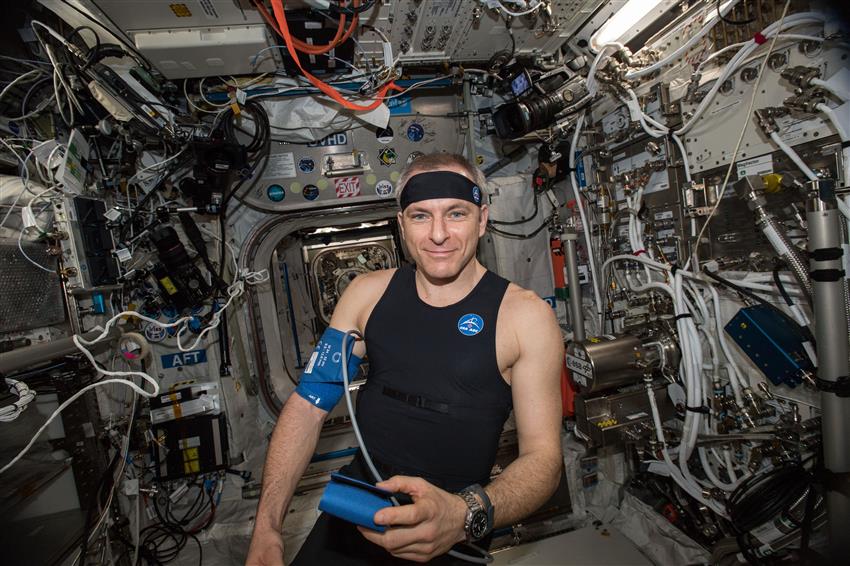CARDIOBREATH: Taking a deep dive into astronaut health
The CARDIOBREATH experiment tracks changes in how astronauts' cardiovascular and respiratory systems control their blood pressure, with the goal of keeping crews healthier in space and upon return.
Background
Human bodies are best suited to life on Earth. When astronauts travel to space and live in a weightless environment, their cardiorespiratory systems adapt – sometimes in ways that can affect their health. For example, the fluids that circulate in their bodies decrease in volume, which means their blood pressure is lower than on Earth.
Researchers are working to understand more about how astronauts' cardiorespiratory systems decondition when they are in microgravity. CARDIOBREATH looks at what can be done to protect astronauts' blood pressure regulation, by examining how astronauts' cardiovascular and respiratory systems interact with their blood pressure control during missions on the International Space Station. To examine this, researchers use the Bio-Monitor, a Canadian-made smart shirt system designed to monitor astronauts' vital signs in space.
Objectives
This study will:
- investigate how astronauts' cardiovascular and respiratory systems interact with blood pressure control
- track these interactions in space to show the deconditioning that weightlessness can cause
- compare data from male and female astronauts to shed light on whether their cardiorespiratory systems adapt to space flight in different ways
How fast a person breathes affects their heart rate and blood pressure – and how fast their heart beats also affects their breathing patterns. Likewise, a person's blood pressure affects their heart rate – and this in turn affects their blood pressure.
By studying these biological feedback loops, researchers will understand more about what happens to astronauts' cardiovascular and respiratory systems in space.
Impacts on Earth
Weightlessness can cause many health issues for astronauts. Studying how cardiorespiratory system deconditioning affects the control of blood pressure in a weightless environment will help researchers come up with ways to keep astronauts healthier.
Meanwhile, the cardiorespiratory changes that happen during space flight are like what happens as people age on Earth and to people who spent a long period in bed rest. Further insights from CARDIOBREATH will help the development of countermeasures and recovery protocols for astronauts, and could also improve the health of elderly patients and all Canadians.
How it works
Researchers aim to study 14 astronauts:
- The participants' cardiovascular and respiratory systems will be tested four times on the ground: twicebefore and twice after the flight. Each subject will wear a custom-fitted Bio-Monitor device and cycle on a stationary bike for 25 minutes at a specific level of effort, while researchers track their heart rate, blood pressure, breathing rate and activity level. Researchers will also take additional measurements in a standing position, such as measuring balance.
- In space, participants will wear custom-fitted Bio-Monitor devices and perform the same cycling exercise session they did on the ground. They will also collect measurements for a few minutes during rest periods before and after the exercise session.
Researchers will compare the results they get on Earth with the results obtained in space. They will also compare the results of male and female astronauts to determine whether sex-based differences exist.
Timeline
Researchers began data collection in early .
Research team
Principal investigator
- Dr. Andrew Blaber, Simon Fraser University
Co-investigator
- Dr. Kouhyar Tavakolian, University of North Dakota

